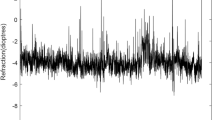Abstract
The aim of this study was to evaluate the effect of convergence and divergence stress on near stereoacuity in healthy individuals. In this experimental study, 38 subjects with fine stereoacuity (≤30 arcsec in TNO test, 17th edition) were enrolled. Near fusional convergence and divergence amplitudes were measured. Near stereoacuity was evaluated at different levels of convergence and divergence stress induced with base-in and base-out prisms. The amount of base-in and base-out prisms that cause a decreased stereoacuity level of >240 and >60 arcsec were noted for each subject. There were 21 female and 17 male visually normal adults (aged 25–32 years) in the study. The mean near convergence amplitude of the subjects was 37.7 ± 6.9 (25–54) prism dioptres (PD), and the mean near divergence amplitude was 16.5 ± 2.8 (10–25) PD. The mean convergence stress that decreased the stereoacuity level to >240 and >60 arcsec were 20.1 ± 7.9 (4–35) PD and 13.9 ± 5.4 (4–30) PD, respectively. The mean divergence stress that decreased the stereoacuity levels to >240 arcsec was 11.5 ± 2.9 (4–18) PD, and to >60 arcsec was 8.7 ± 2.9 (4–18) PD. Decreased stereoacuity is an important criterion for judging deterioration for patients with intermittent deviations. However, it is not clear what might be occurring in these deteriorating patients. We specifically determined that short periods of prism-induced convergence and divergence are accompanied by a decrease in fine near stereoacuity in visually normal adults. Controlling intermittent deviations by using vergence system could be the simple cause of decreased stereoacuity in these patients.
Similar content being viewed by others
References
Jenkins TCA, Pickwell LD, Abd-Manan F (1992) Effect of induced fixation disparity on binocular visual acuity. Ophthal Physiol Opt 12(3):229–301
Jenkins TCA, Abd-Manan F, Pardhan S (1994) Fixation disparity and near visual acuity. Ophthal Physiol Opt 15(1):53–58
Pardhan S, Gilchrist J (1990) The effect of monocular defocus on binocular contrast sensitivity. Ophthal Physiol Opt 10(1):33–36
Bishop P (1987) Binocular vision. In: Moses HW (ed) Adler’s physiology of the eye. CV Mosby, St Louis, pp 619–689
Westheimer G (1994) Seeing depth with two eyes: stereopsis. Proc Biol Sci 257(1349):205–214
Holmes JM, Birch EE, Leske DA, Fu VL, Mohney BG (2007) New tests of distance stereoacuity and their role evaluating intermittent exotropia. Ophthalmology 114(6):1215–1220
Walsh LA, Laroche GR, Tremblay F (2000) The use of binocular visual acuity in the assessment of intermittent exotropia. J AAPOS 4(3):154–157
Laird PW, Hatt SR, Leske DA, Holmes JM (2007) Stereoacuity and binocular visual acuity in prism-induced exodeviation. J AAPOS 11(4):362–366
Laird PW, Hatt SR, Leske DA, Holmes JM (2008) Distance stereoacuity in prism-induced convergence stress. J AAPOS 12(4):370–374
Sheard C (1930) Zones of ocular comfort. Am J Optom 7:9–25
Kromeier M, Schmitt C, Bach M, Kommerell G (2003) Stereoacuity versus fixation disparity as indicators for vergence accuracy under prismatic stress. Ophthalmic Physiol Opt 23(1):43–49
Walraven J (1975) Amblyopia screening with random-dot stereograms. Am. J. Ophthal 80(5):893–900
Fry GA, Kent PR (1944) The effects of base-in and base-out prisms on stereo-acuity. Am J Optom Arch Am Acad Optom 21:492–507
Abd Manan F, Jenkins TC, Collinge AJ (2001) The effect of clinical visual stress on stereoacuity measured with the TNO test. Malays J Med Sci 8(2):25–31
Von Noorden GK, Campos EC (2002) Measurement of vergences. In: Lampert R, Cox K, Burke D (eds) Binocular vision and ocular motility: examination of the patient-II, 6th edn. Mosby, St Louis, MO, pp 202–210
Saladin JJ (1998) Phorometry and stereopsis. In: Benjamin WJ (ed) Borish’s clinical refraction. Saunders, Philadelphia, pp 724–773
Abd-Manan F (2000) The effect of induced visual stress on three dimensional perception. Malays J Med Sci 7(2):18–26
Saladin JJ (1995) Effects of heterophoria on stereopsis. Optom Vis Sci 72(7):487–492
Spencer S, Firth AY (2007) Stereoacuity is affected by induced phoria but returns toward baseline during vergence adaptation. J AAPOS 11(5):465–468
Cole RG, Boisvert RP (1974) Effect of fixation disparity on stereoacuity. Am J Optom 51:206–213
Serrano-Pedraza I, Manjunath V, Osunkunle O, Clarke MP, Read JC (2011) Visual suppression in intermittent exotropia during binocular alignment. Invest Ophthalmol Vis Sci 52(5):2352–2364
Author information
Authors and Affiliations
Corresponding author
Ethics declarations
Conflict of interest
The authors report no conflicts of interest.
Written informed consent was obtained from the subjects and the study was conducted according to the tenets of the Declaration of Helsinki. The manuscript has been read and approved by all the authors.
Rights and permissions
About this article
Cite this article
Demirkilinc Biler, E., Guven Yilmaz, S., Kucukceran, E. et al. The effect of convergence and divergence stress on near stereoacuity. Int Ophthalmol 37, 165–168 (2017). https://doi.org/10.1007/s10792-016-0248-x
Received:
Accepted:
Published:
Issue Date:
DOI: https://doi.org/10.1007/s10792-016-0248-x




